How to crash into a plastic pipe: features of work and analysis of all important nuances
Do you have plastic communications systems in your private home and need upgrades or repairs? Installing plastic on your own is easy, thanks to the features of this material, right? But how to crash into a plastic pipe, if it is under pressure? And is it possible to do it yourself?
We will give you answers to your questions. Here we examined several ways to organize the withdrawal from an existing highway. The insert options are provided with a detailed description of the process and are supplemented with a photo, which will make it possible to deal with the intricacies of the installation technology of cheap and durable plastic pipes.
Following the recommendations in the video, you can do most of the work on your own, without involving experienced plumbers.
The content of the article:
Features of inserting bends into pipes
Pipelines made of plastic are different. Some are used to supply water, others to divert it.
There are public highways, and there are personal house and apartment networks. And each option has its own nuances of the work.
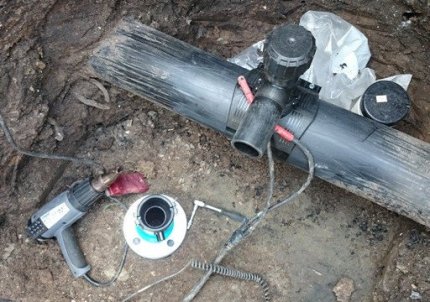
In order to crash into the general centralized system and not get any problems with the law, it is necessary to go through preliminary approvals. It is best to sign all the necessary papers and insert the work itself to a specialized organization. This will greatly simplify life.
But no one bothers to bump into a plastic pipeline inside an apartment or private house. You can do this at almost any point. It is only necessary to observe elementary rules and not to overload the system with an abundance of plumbing devices.
The water pressure in the water supply should be enough for all devices and all users. A sewer pipe can only accept the volume of wastewater for which it was originally designed.
There are several types of plastic pipes:
- "PP" - polypropylene;
- "PE" - polyethylene (most often it is PND);
- "PVC"- polyvinyl chloride;
- "PEX" - made of cross-linked polyethylene;
- PEX-AL-PEX - metal-plastic.
It is recommended to use some of them for distributing hot water supply and heat supply systems, and others only for supplying cold water or its discharge. The insert technology for all plastic pipes is very similar.
The differences relate to ways of connecting them with fittings and with each other in cases where an additional element is inserted into an existing pipeline.
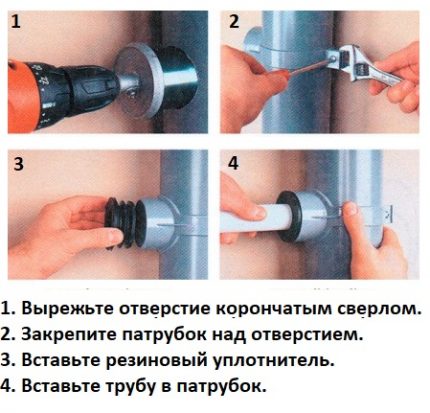
All techniques for inserting a drain into plastic water pipes can be divided into two groups:
- Cutting a pipe section and inserting a tee in its place.
- Overlay on a pipe of a collar (saddle) with a branch pipe.
The first method involves performing welding with a special soldering iron for plastic or using clamping fittings.
In the second case, the presence of the superimposed part is sufficient. It is simply put on the pipe and mechanically tightened with bolts or imposed on a plastic surface and welded to it by means of built-in heating spirals.
Sidebar Options
The most reliable technology for inserting into a plastic water pipe is the method of inserting a tee into it. In fact, this is a common branch installation using standard fittings. First, a section is cut out of the pipeline, and then a part with a tap is mounted in its place. However, it is not always possible to use this option.
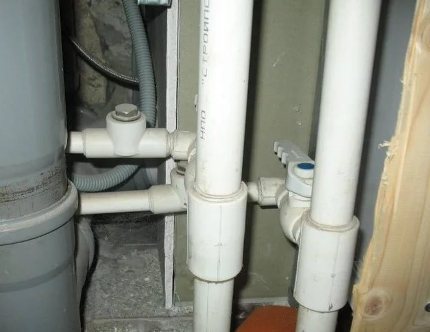
The use of linings (clamps, saddles) simplifies the process of tapping into the water supply. And if it is under pressure, then this is the only possible option. For the installation of the tee, water will have to be completely drained from the plastic pipe, and for insertion using special saddles this is not particularly necessary.
Method # 1 - tee or collector
The main problem with any method of tapping into a water supply system is water pressure. Best when it is blocked. Then it’s just that there will be no spray during the work, which is simply dangerous, since you have to work with power tools. And welding of plastic pipes according to the rules should be done dry.
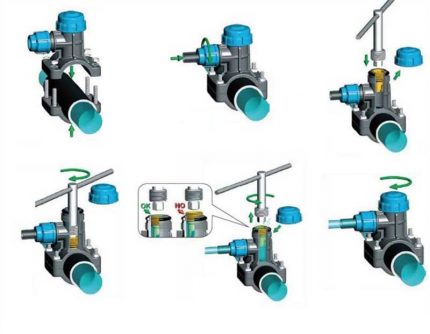
As an insertion element for branch organization, you can use:
- regular tee;
- a manifold for connecting multiple branch pipes.
- a pre-prepared piece of pipe with a soldered bend.
The end with a branch pipe is threaded and soldered. The choice of fitting type depends on varieties of plastic and the type of installation of the entire pipeline system.
If the water supply system was originally made in a collapsible version, then the insert into it should be done with a threaded connection. And if the entire pipeline was running electric welding, then the insertion into it is better to perform in a similar way.
Tee insert technology is as follows:
- Overlapping and completely draining water from the system.
- A pipe cutter cuts a pipe section in size so that it is possible to connect an additional fitting in its place.
- Mounting the tee with a soldering iron (for HDPE and polypropylene) or glue (for PVC).
- Installing a tap valve on the tap.
After installing the tap on the created branch, further work can already be done with the water turned on. Plastic pipes can be welded when tapping the outlet, but also into the socket. Both options are acceptable.
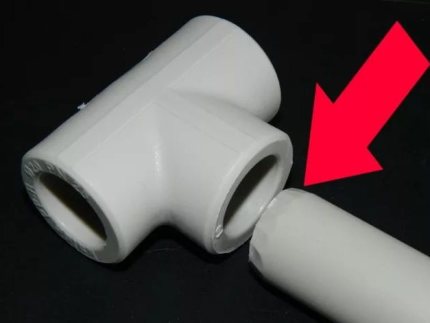
If you get to the water supply with a soldering iron it is problematic because of its proximity to the wall, then you can use collet clamps or press couplings. To do this, first prepare a pipe section with a welded bend, and only then it is inserted into the cutout in the water supply.
The insert into the metal-plastic pipeline is made using a threaded (compression) fitting:
Method # 2 - electrowelded saddle
Under the overhead saddle on the pipe is understood the detail of the water supply, which is intended for the organization of branches from the main highway.
This element greatly simplifies the installation of branching units and does not imply a violation of the through integrity of the tubular product. To perform a tap in a plastic pipe at the insertion point, only a hole of the required size is drilled.
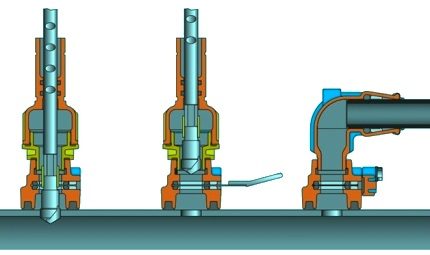
An ordinary saddle is fixed to the pipe with clamps and bolts. Its electrowelded analogue has built-in heating spirals in its design. When voltage is applied to them from the mains, these elements melt the plastic, which after cooling forms a reliable connection between the fitting and the water supply.
The technology for mounting an electrowelded saddle is based on electrodiffusion welding. Moreover, all the heating elements are already mounted in its body at the factory.
It is only necessary to connect them for several minutes to the power supply. In the welding process, it resembles the method using a soldering iron, only in the case of a saddle everything is already assembled in it.
A similar pad is intended for insertion into the PND pipe. It is polyethylene that, when heated, first passes into the desired elastic state, and then hardens without loss of strength characteristics. As a result, the plastic of both parts to be welded is joined into a single mass, which is difficult to tear.
After cooling, the saddle and pipe become an indivisible whole. Such a connection can withstand a water pressure of 16 atmospheres, which is more than enough to complete the installation of a water supply system in an apartment or a cottage. Electric-welded saddles come with and without a built-in cutter - the first option is designed for work on pressure pipelines under pressure without overlapping water.
Installation of such a fitting is extremely simple. It consists of one or two parts. In the first case, this is simply an overlay on the pipe from above, and in the second, a clamp is also connected to it from below for greater reliability. This saddle just needs to be installed on the desired section of the water supply and glued by applying electric current to it.
After the plastic has hardened, it remains only to drill a hole through the pipe in the trunk and connect a hose or pipe to the branch to the plumbing to be connected. Diameter plastic pipe and plunge tap can be very different. It is only necessary to choose the pad of the right size.
Drilling a hole is made with a thick drill or ring mill. The main thing here is not to press too much on the plastic pipe so that it does not crack.
If the milling cutter is already in the saddle, then it is enough to scroll it with a wrench, and then remove it from the drilled hole. Then it remains only to connect the drainage conduit - and the branch is ready.
Method # 3 - crimp clamp (pad)
In addition to the electrowelded saddle, there is its simpler counterpart - the overhead clamp. It consists of two separate parts pulled together by bolts. One for lining the top of the plastic pipe, and the second bottom to attract the upper part. A gasket is additionally inserted between them to prevent leakage.

Usually the upper and lower superimposed parts exactly repeat the dimensions of the pipe. But there are universal clamps, in which the top is made small, and instead of the bottom there is a metal strip for the screed.
Outwardly, they resemble repair analogs for connecting with a hose or closing fistulas. Only in the upper part they have a pipe for connecting the outlet.
Clamps for tapping into a plastic pipe are:
- with stopcock;
- with integrated cutter and safety valve;
- with flange or threaded end made of metal;
- with a plastic butt for soldering or gluing.
To make the insert, the clamp is put on the pipe and fixed on it with nuts or bolts, depending on the design. After that, drilling is carried out through the existing branch pipe. And then the tap itself from the trunk is connected.
Drilling a pipe without installing a clamp or saddle on it is not recommended. You can make a mistake with the diameter of the drill and the drilling point. It is best to do this through the pipe of a fitting already installed for the branch. So the drill in size will definitely be slightly smaller than the internal cross section of the plunged tap and it will be installed exactly where it is needed.
A crimp fitting on a metal-plastic pipe is put using press tongs:
The nuances of working on a water pipe under pressure
For taps in the pressure head pipeline electric welded saddles and clamps with a built-in mill are used. It is located in a special sealed nozzle housing. To drill plastic, it is often enough to turn it with a hex wrench. But there are models for the drill.

Some of these designs include an integrated valve. Then, after drilling is completed, the cutter rises, the valve closes, and the nozzle with the drill is removed. Instead, a branch pipe is mounted.
However, there are also commercially available products with a branch pipe, which is directed laterally from the drill (parallel or at an angle to the connected water supply).
The use of linings with an internal mill allows you to crash into any water pipes. It doesn't matter if they are under pressure or not. But such nozzles are much more expensive than ordinary clamps and saddles.
They greatly simplify the insertion process, but they will have to be spent on. At the same time, they do not exceed and are not inferior to standard solutions in terms of the tightness of the resulting compound.
Conclusions and useful video on the topic
There are many nuances in connecting a branch to a plastic pipeline. There are different types of plastics, and fittings in design, and insertion methods. To prevent blunders, we recommend that you watch the videos below on this topic.
Video # 1. Insertion into a pipe from PND under pressure using a saddle with a mill:
Video # 2. Features of mounting an electrowelded saddle:
Video # 3. Nuances of tapping into a polyethylene water supply:
Crashing into existing plastic plumbing is rare. But sometimes you need to change pipes, install water meters or corny connect additional plumbing. There are several different types of fittings and tie-ins for this.
For any case, there is an optimal option so that the installation can be carried out independently. It is obligatory to delegate these works to professional plumbers only in situations of connection to a common water supply system, where preliminary approvals are required.
Please write comments in the block located under the test article. Tell us how the insert was made into the polymer pipe with your hands. Share information useful for site visitors, ask questions, post posts with your opinion and a photo on the topic.

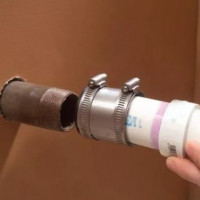 The connection of plastic pipes with metal: an analysis of the best methods and mounting nuances
The connection of plastic pipes with metal: an analysis of the best methods and mounting nuances 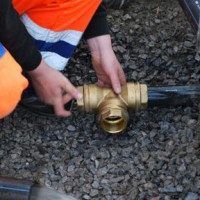 Inserting into a pipe without welding: a review of the technology for mortise work
Inserting into a pipe without welding: a review of the technology for mortise work  Soldering polypropylene pipes: work rules and analysis of possible errors
Soldering polypropylene pipes: work rules and analysis of possible errors 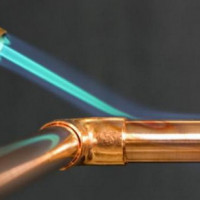 Soldering of copper pipes: step-by-step analysis of work and practical examples
Soldering of copper pipes: step-by-step analysis of work and practical examples 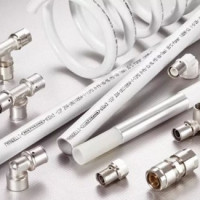 Press fittings for plastic pipes: types, marking, purpose + installation example
Press fittings for plastic pipes: types, marking, purpose + installation example 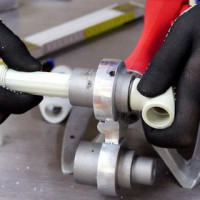 DIY welding technology for polypropylene pipes: an overview of methods and nuances
DIY welding technology for polypropylene pipes: an overview of methods and nuances  How much does it cost to connect gas to a private house: the price of organizing gas supply
How much does it cost to connect gas to a private house: the price of organizing gas supply  The best washing machines with dryer: model rating and customer tips
The best washing machines with dryer: model rating and customer tips  What is the color temperature of light and the nuances of choosing the temperature of the lamps to suit your needs
What is the color temperature of light and the nuances of choosing the temperature of the lamps to suit your needs  Replacement of a geyser in an apartment: replacement paperwork + basic norms and requirements
Replacement of a geyser in an apartment: replacement paperwork + basic norms and requirements